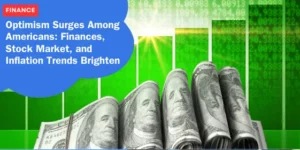Why Economic Frustration is Gripping Americans Today

Today, it is widely observed that US consumers are grappling with the unrelenting pressure of high inflation and elevated interest rates.
This double whammy has strained household finances significantly, and many Americans feel the weight of these economic burdens more acutely than ever before.
The Persistent Economic Frustration
Consumer Confidence and Inflation Expectations
In recent months, consumer surveys such as the Consumer Confidence survey from The Conference Board have consistently highlighted that prices remain a primary concern for Americans.
Participants in the survey have expressed expectations that both inflation and interest rates will continue to rise over the coming year.
The Impact on Spending
While shoppers have been contending with elevated prices and interest rates for some time, this painful combination has now started to substantially affect their spending behavior.
As spending slows and financial strain intensifies, it is anticipated that this situation will worsen over the next few months. However, despite these challenges, a full-blown recession may still be avoided.
The Resilient Yet Struggling Consumer
Post-Pandemic Spending and Savings Depletion
Throughout 2023, US consumer spending remained surprisingly robust, buoyed by a post-pandemic spending spree.
Consumers leaned heavily on their pandemic savings and credit to sustain their purchasing activities.
This continued even in the face of high inflation, driven by a sense of security afforded by widespread employment and perceived job opportunities.
Financial Stretch
Fast forward to the present: consumers are increasingly feeling financially stretched.
Pandemic-related savings have been depleted, wage growth is slowing, and household debt is rising rapidly.
Elevated debt levels combined with high interest rates mean that a bigger chunk of income is being diverted towards interest payments, leaving less for goods and services.
Growing Debt and Delinquencies
As more households reach their credit limits, the difficulty in servicing and repaying debts has intensified.
Delinquencies are on the rise, with approximately a third of maxed-out borrowers having fallen behind on their payments over the past year, according to data from the New York Federal Reserve.
Declining Consumer Confidence
Financial Worries
When questioned about their current and future financial situations, consumers’ worries have grown since February.
An increasing number of individuals report that their financial situations are deteriorating, with fewer expecting improvements.
For four consecutive months, the Expectations Index a consumer sentiment measure based on income, business, and labor market outlooks—has remained in a range that typically signals a potential recession.
Consumer Caution and Spending Trends
With inflation persisting and interest rates likely to stay high, consumer caution is understandable.
Retail sales stagnated in April, even showing a decline month-over-month when adjusted for inflation.
Spending on cars, sporting goods, and dining out at restaurants has noticeably weakened.
Major retailers such as Walmart and The Home Depot have confirmed these softened trends, reporting hesitancy among consumers to spend on non-essential items and a shift towards cheaper substitutes.
Retail Market and Promotions
Efforts to Stimulate Spending
In May, retail giants like Walmart and Target implemented promotional strategies to sustain spending.
Walmart announced discounts on 7,000 items, while Target revealed price cuts on 1,500 items.
Although these promotions provide relief for consumers still paying around $3 for a dozen eggs—nearly double the pre-pandemic price—these efforts may not significantly boost overall consumption.
Nowadays, services are more influential in driving inflation than goods.
Prices for housing, utilities, transportation services, insurance premiums, and healthcare are the primary factors squeezing consumer finances, as per recent analysis.
Consumer Adjustments
Faced with persistent inflation and high interest rates, consumers have indicated plans to reduce indebtedness, delay spending on financed items, and increase savings efforts.
According to our January Consumer Confidence survey, cuts in expenditures on dining out, clothing, entertainment, and vacations are likely to continue contributing to the recent consumption softening.
This trend will persist until inflation slows further and interest rates begin to drop.
Economic Outlook and Policy Expectations
Short-Term Headwinds
While these headwinds are real and pose a drag on the economy for much of this year, they should not be overestimated.
Despite financial pressures, consumers do not appear so squeezed that they plan to cut essential spending.
The strong labor market will likely continue to support incomes, with our latest CEO Confidence survey suggesting persistent strength in employment.
Most executives plan to maintain or increase workforce levels and raise wages by over 3% in the next 12 months.
Economic Projections
Overall, although consumer spending ability and willingness may remain under duress in the coming months, a contraction severe enough to plunge the economy into recession is not expected.
As economic growth slows, inflation is projected to decelerate gradually, with the Federal Reserve aiming for a 2% target by 2025.
As inflation moderates and growth stabilizes, expectations are that the Fed may begin cutting interest rates towards the end of 2024, offering some relief to debt-laden consumers.
Broader Conclusions
Influences on the Middle Class
High interest rates and inflation have exerted significant pressure on middle-class American budgets.
The Federal Reserve’s efforts to combat inflation by raising interest rates have driven up borrowing costs, impacting everything from mortgages to credit card debt.
This has further squeezed household budgets, making it challenging for many middle-class families to save or invest for the future.
Housing and Job Market Strains
Increased housing costs have intensified financial strain for many middle-class households, with homeownership becoming increasingly elusive due to escalating home prices and higher mortgage rates.
Renters face similar challenges, with rising rental prices consuming a larger share of household income.
The labor market, though strong in some sectors, has experienced volatility and uncertainty.
Slowdowns in job growth and layoffs in various industries contribute to financial insecurity for middle-class workers.
Strategies for Navigating Economic Challenges
Financial Management and Education
Effective financial planning and budgeting are critical tools for middle-class families facing economic challenges.
Households must explore ways to cut discretionary spending, manage debt, and build emergency savings.
Budgeting apps and financial advice services can help households develop strategies to better manage their finances.
Leveraging Technology
Technological advancements in financial management tools provide opportunities for consumers to optimize their finances.
Personal budgeting apps, automated savings accounts, and investment platforms can assist families in maintaining financial discipline and achieving long-term financial goals.
Additionally, online financial education resources can significantly enhance financial literacy, empowering individuals to make informed decisions.
Community Support and Policy Advocacy
Community resources and support programs are vital for assisting families during financial hardships.
Local non-profits, community centers, and government programs offer crucial assistance with food, housing, and utilities, helping bridge the gap during tough economic periods.
Advocating for policy changes that address fundamental economic issues, such as affordable housing, healthcare, and education, is also essential for long-term improvement.
Conclusion: Navigating Economic Uncertainty
In conclusion, the economic frustrations gripping American consumers are rooted in persistent inflation, high interest rates, and rising living costs.
Although these challenges are significant, by employing strategic financial planning, leveraging technology, and seeking community support, individuals can navigate these uncertain times more effectively.
Moreover, advocacy for policy changes that address underlying economic challenges will be crucial for creating a more equitable and sustainable economic environment.
Through a combination of immediate coping mechanisms and long-term policy solutions, a comprehensive approach can be developed to mitigate the economic strain faced by Americans today.
Here’s how various stakeholders can contribute to this effort.






